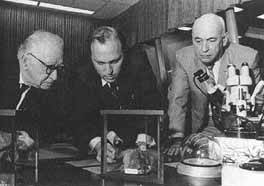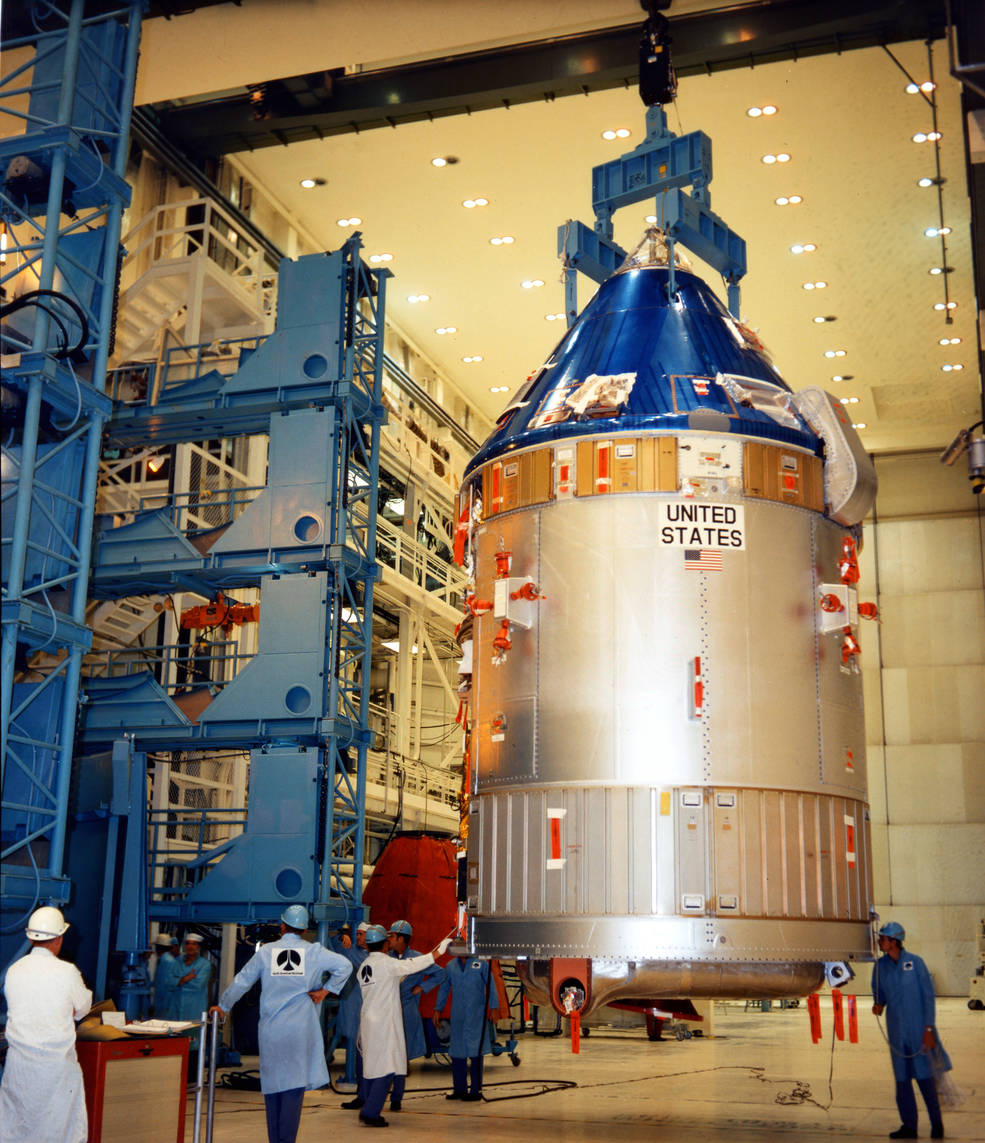In preparation for their Jan. 31, 1971 liftoff, Apollo 14 astronauts Commander Alan B. Shepard, Command Module Pilot Stuart A. Roosa, and Lunar Module Pilot Edgar D. Mitchell, along with their backups Eugene A. Cernan, Ronald E. Evans, and Joe H. Engle began a preflight quarantine to prevent them from contracting any communicable diseases. During this partial medical isolation, they continued to rehearse various aspects of their upcoming mission in spacecraft simulators and received their final lunar geology briefings. In Houston, hundreds of scientists met to discuss the results of their analysis of lunar samples returned by the Apollo 11 and 12 crews. A Soviet scientist attended the conference to describe the samples returned by the automated Luna 16 probe in September 1970.


Left: Illustration of the planned Apollo 14 lunar traverses at the Fra Mauro landing site. Right: Illustration of the placement of the surface scientific instruments at the Apollo 14 landing site.
On Jan. 11, 1971, the Apollo 14 astronauts began a preflight semi-quarantine at NASA’s Kennedy Space Center (KSC) with a limited number of personnel having direct access to the crew members even as they continued simulator runs to rehearse various aspects of their upcoming mission. Flight surgeons instituted the measures as part of the flight crew health stabilization program to prevent a recurrence of an Apollo 13 crewmember’s exposure to German measles, requiring a last-minute crew change. The astronauts reviewed the planned lunar surface and lunar orbit science scheduled for their mission. The two moonwalkers planned to deploy six experiments as part of the Apollo Lunar Surface Experiment Package (ALSEP), consisting of:
- The Passive Seismic Experiment (PSE) detected moonquakes, natural and artificial, to better understand the Moon’s internal structure.
- The Active Seismic Experiment (ASE) sought to understand the internal structure of the Moon’s upper layers and consisted of a mortar package to lob a set of explosives to various distances and an astronaut-operated “Thumper” to set off small seismic events. A set of geophones recorded the resulting shock waves.
- The Suprathermal Ion Detector (SIDE) measured various properties of positive ions in the lunar environment and provided information on the interaction of the solar wind with the Moon.
- The Cold Cathode Ion Gauge (CCIG) measured the pressure of the thin lunar atmosphere.
- The Charged Particle Lunar Environmental Experiment (CPLEE) measured the fluxes of charged particles (electrons and ions) at the lunar surface.
- The Lunar Dust Detector (LDD) measured the amount of dust that accumulated on the lunar surface.
Three other surface experiments, not part of the ALSEP suite, included:
- The Laser Ranging Retro Reflector (LRRR) consisting of an array of silica cubes to reflect a beam of light precisely back to its point of origin to accurately measure the Earth-Moon distance.
- The Lunar Portable Magnetometer (LPM) to measure the strength of the Moon’s magnetic field.
- The Solar Wind Composition (SWC) experiment to collect solar wind samples for analysis by scientists back on Earth.
In addition to their studies on the lunar surface, the Apollo 14 astronauts planned to perform several studies of the Moon from lunar orbit. The S-Band Transponder Experiment measured regional variations in the Moon’s gravitational acceleration, and the Bistatic Radar Experiment measured the scattering of radar waves from the lunar surface. They also planned to conduct six other experiments and science demonstrations during the course of their nine-day mission.


Left: Attendees at the Second Lunar Science Conference in Houston. Right: In the Lunar Receiving Laboratory at the Manned Spacecraft Center (MSC), now NASA’s Johnson Space Center, in Houston, Academician Aleksandr P. Vinogradov, left, of the Soviet Academy of Science, examines a Moon rock returned by Apollo 12 with NASA scientist Michael B. Duke of MSC’s Lunar and Earth Sciences Division and MSC Director Robert R. Gilruth.
The week of Jan. 11, 1971, 750 scientists gathered at the Albert Thomas Convention Center in Houston for the Second Lunar Science Conference. More than 175 principal investigators presented the findings of their studies of the lunar material returned by the Apollo 11 and 12 missions and the results of the experiments deployed by the astronauts at the two landing sites. This second lunar conference featured the presence of Academician Aleksandr P. Vinogradov, vice president of the Soviet Academy of Science and director of the Vernadsky Institute for Analytical Chemistry in Moscow. He presented the results of the examination of lunar samples returned by the Soviet automated sample return probe Luna 16 in September 1970. Robert R. Gilruth, director of the Manned Spacecraft Center (MSC), now NASA’s Johnson Space Center, in Houston, hosted Academician Vinogradov at the facility, where MSC scientist Michael B. Duke toured him through the Lunar Receiving Laboratory and showed him a Moon rock returned by Apollo 12.



Left: The Apollo 15 Command and Service Modules after mating in the Manned Spacecraft Operations Building (MSOB) at NASA’s Kennedy Space Center. Middle: The Apollo 15 Lunar Module (LM) descent stage after arriving in the MSOB. Right: The Apollo 15 LM ascent stage in the MSOB.
Apollo 15 crewmembers Commander David R. Scott, Command Module Pilot Alfred M. Worden, and Lunar Module Pilot James B. Irwin and their backups Richard F. Gordon, Vance D. Brand, and Harrison H. “Jack” Schmitt continued training for their upcoming July 1971 mission, including practicing driving the 1 g training version of the Lunar Roving Vehicle (LRV). They also spent time attending various sessions at the Second Lunar Science Conference. The Apollo 15 Command and Service Modules arrived at KSC on Jan. 14, and workers in the Manned Spacecraft Operations Building (MSOB) mated the two craft four days later. Engineers continued testing Apollo 15’s Lunar Module, modified to accommodate the LRV and enable a longer lunar surface stay, and mated the ascent stage to the descent stage on Feb. 9. In the nearby Vehicle Assembly Building, on Feb. 2, workers rolled the assembled Saturn V rocket for Apollo 15 from High Bay 1 to High Bay 3. This was done to free up High Bay 1 since it was dedicated to the assembly of the “milkstool” platform on the Mobile Launcher to permit the stacking and launch of the Saturn 1B rockets for the Skylab Program. Because the actual Apollo 15 spacecraft modules resided in the MSOB, for the rollover, engineers topped the Saturn V with a dummy Apollo spacecraft, without a Launch Escape Tower fitted on top.



Left: Apollo 15 astronauts James B. Irwin, left, David R. Scott, and Alfred M. Worden posing with the Lunar Roving Vehicle, a mockup of a Lunar Module, and a Particle and Fields Subsatellite. Middle: The Apollo 15 Saturn V rocket in front of the Vehicle Assembly Building (VAB) during the rollover from High Bay 1 to High Bay 3, seen backing out of High Bay 1 here. Right: The Apollo 15 Saturn V reentering the VAB into High Bay 3.
To be continued…
John Uri
NASA Johnson Space Center

























